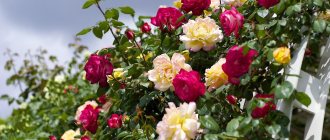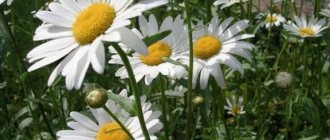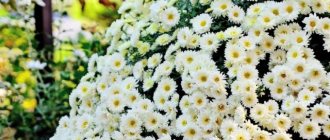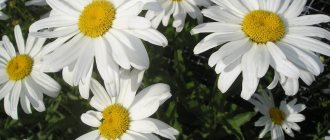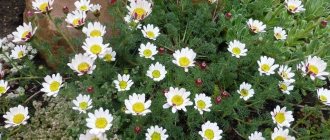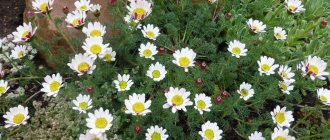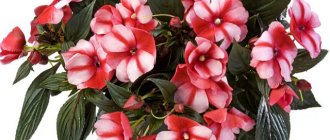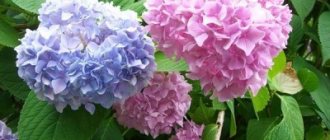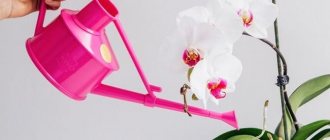≡ Home → Chamomile → Properties of chamomile →
Very often, daisies are called multi-colored flowers that are similar to them due to the structure of the inflorescences typical of aster plants. Most people associate them with a convex core and long petals, and seeing such an inflorescence, a person involuntarily calls it a chamomile. Although in most cases such plants are not daisies.
It is obvious to most people that these are not daisies, but without knowing the name, they might call them white or purple daisies for simplicity.
True daisies belong to the genus Matricaria, which, with a few exceptions, is characterized by a combination of only two colors - yellow and white. As a rule, true daisies have small tubular yellow flowers on the receptacle, and white reed flowers around it. Only two species of Matricaria - golden and green daisies do not have reed flowers, and they got their names due to the color of the tubular ones.
True chamomile
All colored or multi-colored daisies are called this only in common parlance, while in the scientific community these plants have completely different names. Most of them belong to the Asteraceae or Compositae family, which includes more than 30 thousand plant species, which explains some of their visual similarity.
Chamomile, green and golden
The most famous type of chamomile is the chamomile, which is scientifically called Matricaria chamomilla. Its leaves are very small, simple, sessile with pinnately dissected venation. Knowledge of these features helps to distinguish the plant from species with similar inflorescences.
The leaves of true chamomile are similar to dill leaves.
The size of chamomile inflorescences is about 2.5 cm in diameter. There are two types of flowers in its basket. On the convex receptacle, which as the bush ages, takes on an almost conical shape, there are small yellow flowers with a simple perianth. White reed flowers grow along the outer contour of the receptacle, the number of which is usually 12 or 18 pieces.
At the moment of flowering, the chamomile bush looks like this:
Inflorescences similar in color combinations are found in odorless chamomile, some types of navels (including dog chamomile and field chamomile), Roman chamomile, some pyrethrums and tansy.
Chamomile belongs to the genus Matricaria, which includes only 25 plants. They are considered true daisies, while other plants are called that only in common parlance, having other names.
Most species of Matricaria are characterized by the same structure of inflorescences and a combination of only yellow and white flowers. The exceptions are green chamomile, which is also called fragrant or tongueless, and in the scientific community - Matricaria discoidea, and golden chamomile - Matricaria aurea.
The green inflorescences contain only tubular flowers, which, as the name suggests, are green in color. It has no edge “petals” at all. The plant is also distinguished by a strong specific smell and the small height of the bushes. As a rule, they grow to only 20-30 cm. As can be seen from the photograph, in appearance they are very different from chamomile bushes:
The golden chamomile is quite similar to this species. It differs from green mainly only in the color of the inflorescences, which in this plant is yellow. The diameter of the inflorescences is very small - no more than 0.8 cm, and the height of the bushes is about 25 cm. An important feature of the species is that flower baskets can grow singly, and not in corymbose inflorescences, as in most other representatives of the genus Matricaria.
Features of planting and caring for crops
Garden chamomile
Note! You will have to buy seeds anew each time, since if you collect seeds from last year’s plants, their descendants may not retain their parental qualities.
In April-March, the seeds are planted to a depth of 3-4 mm, kept at a temperature of at least 20 degrees, after which they are planted in pots or special peat cups, in which the shoots are then planted in the ground. Young shoots can withstand light frosts, while adults can easily tolerate slight sub-zero temperatures. In the southern regions, it is possible to plant seeds directly into the beds; this is done in late August-early September.
Pyrethrum prefers loose soil rich in nutrients. Do not plant it in dry, sandy or clayey infertile soil. Also, low-lying places with stagnant water are not suitable; garden chamomile does not like abundant moisture, especially at low temperatures. A shady location with only a few hours of sun each day is ideal.
Small chamomile
Pyrethrums should be planted at a distance of 20-30 cm from each other; in the first weeks they need abundant watering. Perennial plants begin to bloom the very next year after planting.
Caring for small chamomile is not difficult, so this plant is ideal for those who do not have a lot of time to work in the garden. The only thing the plant needs is systematic watering. Pyrethrum copes well with weeds on its own; they need to be removed only during the growing season, and then loosen the soil a little to avoid the formation of a dense crust that prevents water from reaching the roots.
Pyrethrum is fed with various mineral fertilizers, but you should not use nitrogen fertilizers: in this case, the plant will only grow the green part, and the flowers will become small and sparse. Organic fertilizers such as manure or humus are also great for chamomile. After the first flowering, it is recommended to remove all inflorescences without waiting for the seeds to prevent repeated flowering.
Important! Garden chamomile must be replanted every four years, otherwise flowering will become poor.
Yellow daisies
Many other types of aster plants also have the inflorescence structure characteristic of daisies. Because of this, they are also often called daisies, adding an epithet to describe their color. Thus, many plants are popularly called yellow daisies, while such a term does not appear in the scientific community.
Without knowing the correct names, yellow daisies are most often called:
- Doronicum orientalis;
- Coreopsis;
- Rudbeckia;
- Erigeron linearis;
- Ursinia is beautiful;
- Helenium and some other plants.
- Doronicum eastern.
Its inflorescences are larger than those of daisies, and the marginal flowers are yellow or golden in color. The plant is perennial.
It is also useful to read: What are the benefits of chamomile tea for women?
The same color is found in some species of coreopsis. Moreover, the cores of these plants can be not only yellow, but also brown or burgundy. Their reed flowers, as a rule, have jagged edges.
These photographs show several species of coreopsis:
Terry coreopsis
Various types of rudbeckia are also called yellow daisies, among which there are both annuals and perennials. Among the latter, the most common is the brilliant rudbeckia, which is characterized by a tall stem and large inflorescences. The shrubs reach a height of 60 cm, and the diameter of their inflorescences is 8-10 cm. Their petals are bright yellow and velvety to the touch, and the center is dark brown.
In flower beds and gardens you can often find hairy rudbeckia. This is an annual bush plant, smaller in size than the brilliant rudbeckia. It also differs in the color of the marginal flowers. Along the outer contour they are yellow, and in the middle they are dark burgundy or brown, as in the photo below:
Here the photo shows a beautiful Ursinia:
This annual is similar to rudbeckia in the color of the marginal flowers, but differs in the height of the bushes, which does not exceed 30 cm. Because of this, it is sometimes called small-flowered yellow daisy.
Of the wild plants, yellow daisies are called Erigeron lineart. This is a low-growing perennial shrub, the height of which is no more than 20 cm. Its inflorescences are also small - from 1 to 2 cm in diameter. They grow one at a time on separate stems.
Some types of helenium are also called. They differ in the height of the stems, which can grow up to 160 cm. At the same time, the diameter of the inflorescences rarely exceeds 5 cm. The most characteristic color for them is yellow, but cultivated varieties also have brown and purple shades. Very often helenium can be found in flower beds along with daylilies and lilies.
There are a lot of plants that resemble yellow daisies. In addition, sometimes even flowers that have more different than similar features are called this way, for example, gerberas, large-flowered chrysanthemums and asters.
Gatsania
The flower has an incredible variety of shades: yellow, lilac, red, orange, etc. There are also two-color and striped varieties. Externally, gatsaniya really resembles a chamomile, only with brighter and more colorful petals. Gradient varieties, where one color gradually gives way to another, do not allow you to take your eyes off the bush.
Under natural conditions, there are about 40 species that are resistant to frost, direct sunlight, drought and high temperatures. Flowering starts at the beginning of summer and continues until night frosts. The height of the bush is within 30-40 cm. The flower retains its appearance for a long time after cutting.
Gatsania is grown in open ground, pots and flowerpots. It combines well with other plants in the flowerbed and looks impressive when planted alone. The species is used to decorate paths, borders and rock gardens.
Blue and lilac flowers
Aster plants have inflorescences with lilac and blue flowers. Without knowing the correct names, they are also called daisies. Most often it is called this:
- Pyrethrum;
- alpine aster;
- Felicia;
- Anemone;
- Catananche and some other plants.
Pyrethrum inflorescences are most similar to chamomile. Their structure is practically the same, only the size of the flower baskets and the color of the reed flowers differ. In some species they are bright lilac in color.
Alpine aster inflorescences have a yellow center, and the petals have a light lilac color. Their size and quantity are much larger than those of chamomile. In aster, reed flowers grow in 2 or 3 rows, making the inflorescence appear large and fluffy.
Several varieties of Felicia are called blue daisies. This is a small perennial shrub that produces a lot of inflorescences. In some varieties, the tubular flowers are yellow, and the marginal flowers are blue or lilac. There are also varieties with a bright blue core and blue petals.
Here the photographs show felicia ameloid shrubs:
...and bergers
And this is a tender anemone:
It has longer tubular flowers that are yellow in color and have blue-violet marginal flowers. They grow on single stems, about 20 cm high. Although the anemone is called chamomile, it not only belongs to a different genus, but also belongs to another family - Ranunculaceae.
Catananche flower baskets have a very beautiful bluish-lilac color. Their reed flowers are arranged in 3-5 rows, making the inflorescence appear larger and fluffier. The edges of the flowers are jagged, and at the base their color changes from light blue or lilac to purple.
Chrysanthemum
A perennial or annual plant with many varieties. Flowers are located on a separate stem or are included in massive inflorescences. The petals are cream, lilac, yellow, purple and lilac. The height of one branch varies depending on the variety, in rare cases it can grow up to 160 cm. The plant is stable after cutting.
The chrysanthemum variety Bacardi deserves special attention. You should remember the name and look at the photo, because chamomile-like flowers can be used to create a wide variety of compositions. The variety has white, densely set petals and a yellow center, which together gives an incredible similarity. There are up to two dozen buds on one large stem, so literally 3-5 branches allow you to form a lush, beautiful bouquet.
In addition to the standard color, the petals can be red, yellow, pink, or cream. This flower is popular among florists - its inflorescences are painted in various shades, sprinkled with sparkles, and decorated with ribbons.
The Bacardi variety is grown outdoors and at home. It is placed on sunny lawns and provides abundant watering.
Plants with colorful inflorescences
Some plants have multicolored inflorescences. Often 2-3, and sometimes even more, shades are combined on one petal. Thanks to this, the plants look very impressive and exotic.
It is also useful to read: All the medicinal properties of chamomile, both confirmed and unverified
Multi-colored daisies are called:
- Gaillardia spinosa;
- Osteospermum;
- Gazania;
- Venidium;
- Arctotis;
- Ursinia umbilicus and other similar flowers.
Gaillardia spinosa is a perennial shrub whose stem height reaches 90 cm. The diameter of the flower baskets is usually from 7 to 12 cm. The tubular flowers located in the center are dark red or burgundy in color. The petals of this plant are three-toothed. Along the outer edge they are colored yellow, and closer to the middle - red or purple. In some varieties they are arranged in several rows.
Gaillardia bushes look like this:
This plant is sometimes confused with helenium, some varieties of which have almost the same color of flower baskets.
Many varieties of osteospermum are also often called colored chamomile. Their inflorescences can combine a variety of shades: pink, white, red, lilac and others.
Here the photo shows osteospermum tricolor:
An abundance of color variations is also inherent in gazania. Its inflorescences are very large, and its petals are pointed. They can combine 3-4 color shades at once. The photographs show some plant varieties:
On a note
Gazania and osteospermum are often grown not only in open ground, but also in pots. Their bright inflorescences and long flowering period make them a wonderful home decoration. You can grow these flowers either from seeds or by purchasing seedlings. Their prices are much higher than for seeds, however, according to reviews, they almost always take root well.
Venidium boasts even larger and brighter flower baskets. Their diameter ranges from 10 to 14 cm, and the height of the bushes can reach 80 cm. Its reed flowers have pointed or rounded edges. They come in white, yellow, orange, red and some other colors. Moreover, in almost all varieties the center is black, and around it, on the edge flowers, a ring of a contrasting color is outlined - brown, burgundy or purple.
A similar color is found in Arctotis. Some varieties also develop a ring of a different color around the core. At the same time, its petals are more pointed, and the diameter of the baskets is slightly smaller.
Here the photo shows Venidium bushes:
And here is arctotis:
And this is Ursinia umbilicalis:
As can be seen from the photograph, its marginal flowers are colored at the base in a rich brown color, which gradually turns into burgundy, and then into bright orange.
Interesting facts about large chamomile
Columbus not only discovered America to the world; chamomile also became one of the souvenirs the traveler brought after his round-the-world adventure. It is not surprising that the country discovered by Christophor is officially considered the birthplace of the much-loved domestic chamomile.
But they learned about the beneficial properties of the plant already in the Old World. Where it was called “Romanova grass”. In our homeland, the flower appeared already in the 19th century, but it was called a belyushka or a vorozhka.
In Egypt, chamomile has long been considered an antipyretic, and the creation of the flower was attributed to the ancient sun god Ra. While the Scandinavians and Germans offered snow-white flowers with a yellow core to the main Deity living in Asgard, Odin.
https://sornyakov.net/flowers/romashki-sadovye.htmlhttps://7ogorod.ru/cvety/romashka-sadovaya.htmlhttps://profogorod.ru/sadovodstvo/kustarniki/kak-vyrastit-krupnuyu-romashku.html
Pink, red and other daisies
Since the Asteraceae family includes more than 30 thousand different plants, and the inflorescences of many of them have a similar structure, daisies are often called the most diverse and seemingly completely different flowers. For example:
- Anacyclus;
- Cosmea;
- Erigeron;
- Echinacea and many others.
Anacyclus is called pink daisy. Its center is yellow, and the edge petals are pale pink, but on the reverse side they are painted a rich crimson color. Anacyclus bushes are very low, its stems grow only up to 10 cm. Thanks to these features, the plant is easy to identify. Cosmos flowers are visually familiar to many, since they are often planted in flower beds, but only specialists know its correct name. Cosmos inflorescences differ from chamomile flowers not only in color, but also in size. Their petals are approximately 2-3 times wider. The color of the tubular flowers of cosmos is usually yellow, and the color of the marginal flowers is white, pink, purple or multi-colored.
Cosmos bushes look like this:
And here is a bush of phlox, with which cosmos is sometimes confused:
Erigeron is also mistakenly classified as matricaria. At the same time, plants of this species have obvious differences. Their petals are very narrow and pointed, and on the inflorescences they are arranged in several rows. The colors of flower baskets are completely different. They can combine white, yellow, lilac, burgundy, orange and other colors.
Similar to chamomile and echinacea inflorescences. Most often they come in yellow, pink and lilac colors.
Pyrethrum
Another double of the chamomile, which is a highly branching bush, 20-50 cm high. The opening buds can reach 8 cm in diameter, their petals are colored white, pink, crimson, red and lavender. The flower is grown as an annual and perennial crop and has an effective ability to self-sow. Planting is possible in almost any soil, but waterlogging and stagnation of water should be avoided.
Flowering begins in May and continues for a long period. The aroma is strong and quite specific.
Types and their characteristics
Many years ago there was a belief that chamomile grew in the place where a star fell. Since stars vary greatly in size, color, brightness, etc., plants also divided into many varieties. When purchasing garden chamomile at agricultural exhibitions or in specialized stores, a person gets lost in the variety of varieties. But you should always know what large daisies are called, since maintenance and care may vary slightly.
The most common varieties are:
- Bush chamomile, or cornflower;
- North Star;
- Alaska;
- Princess;
- Colored varieties.
Nivelberry is the most common type of bush giant chamomile, which, in most cases, is grown for sale. Grows up to 1 meter in height. Large daisies, the flowers are about 20 cm in diameter (wider than a human hand). This is a tall, strong flower, which has a central part of a regular, gently sloping shape and a rich yellow color. Perennial Compositae. Resistant to low air temperatures. It can reproduce once every 4 years by dividing the bush. You can also use the seed propagation method.
North Star is the most unpretentious variety of large-flowered chamomile. The size of the blossoming buds is about 12 cm. It stretches 35-40 cm in height. The variety loves the sun's rays, so it is not advisable to plant it in the shade. Planting in a garden plot occurs either in spring or autumn. This species will begin to bloom only in the second year after planting.
Alaska chamomile grows up to 80-90 cm in height. The diameter is 12 cm. If planting took place in the autumn season, next summer it will delight the gardener with its long flowering. Loves sunny areas protected from drafts and wind. Tolerant to lack of moisture, frost-resistant.
Alaska chamomile
Silver Princess is a low-growing species that does not grow above 35 cm. At this height, the flowers are 10 cm in diameter. It differs from other varieties in its longer flowering time. It begins in early July and ends with the first frost. Doesn't like drought.
Colored varieties are also divided into types. Among multi-colored daisies, the most popular are:
- Persian - blooms throughout the summer. Likes moderate watering, prefers shaded areas. In most cases it has a delicate pink tint. Large perennial garden daisies.
- Red pyrethrum - distinguished by the large size of beautiful flowers, bright red color. Drought resistant. In severe frosts, it requires shelter.
- Yellow Doronicum is the earliest flowering variety. Begins to bloom at the end of March. The flowers are yellow. It is unpretentious to the soil and does not require special care. The plant blooms for a longer time if it grows in shaded areas. Reaches 70 cm in height. Perennial daisies.
- Blue is a relatively young variety. Characterized by blue and blue flowers. It is widely used in medicine thanks to the essential oil obtained during the processing of flowers. The flower size is small. Life period – 1 year.
- Orange petal is a fast-growing variety. The flowers are not large, orange in color, the flower petals are narrow and long. Very rarely grown for sale, more often for use in landscape design.
Flower propagation
After 2-3 years, the bushes begin to overgrow, losing their strength and attractiveness - they need to be separated. Timely planting of young shoots will help preserve the beauty of flowers and plant new bushes.
Reproduction can be carried out by division and seed. The second method is rarely used.
You can grow flowers in one place for no more than 5 years.
Reproduction by division is carried out in the following way:
- Young, healthy shoots along with the root system are separated from the mother bush from the side. The procedure is carried out on a cloudy, cool day. Time: last days of September, beginning of October.
- The separated stem is planted in a hole prepared in advance. Before planting the cutting, the hole is moistened with settled water containing a growth stimulator.
- The hole is filled with fertile soil and lightly compacted.
After a year, the stems for propagation are cut off from the other side of the mother bush. To maintain the active growth of large inflorescences, this procedure must be carried out annually.
Propagation by division is an effective method that simultaneously thins out the bushes and allows you to get new flowering bushes
Seeds can be purchased ready-made or collected yourself:
- seed material is collected from completely dried flowers - the petals should be dry and the baskets should become brown;
- the inflorescences are cut off and left in a dry place with good ventilation to dry completely;
- the collected seeds are dried and poured into a paper bag for storage; a hole is made in the bag to allow air to enter.
Seed germination persists for several years.
Seeds can be planted in the soil before winter; they will not be lost from frost, but will undergo stratification, thanks to which the plant will be strong.
How to choose a flower that looks like a daisy?
Among the listed variety, every daisy lover will find a suitable option. The choice depends on the properties of the varieties, preferences in colors and plant size. Chamomile-like flowers come in different colors, heights and even types (grass, shrubs) . They are selected for any ensemble in a flowerbed and they will last for many years, delighting with bright colors and long-lasting flowering.
- Author: Maria Sukhorukikh
Rate this article:
- 5
- 4
- 3
- 2
- 1
(0 votes, average: 0 out of 5)
Share with your friends!
